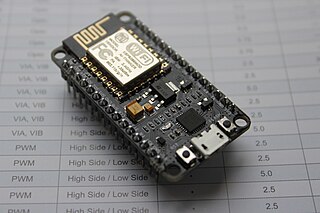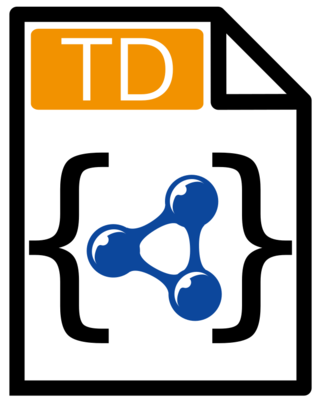
In computing, a visual programming language, also known as diagrammatic programming, graphical programming or block coding, is a programming language that lets users create programs by manipulating program elements graphically rather than by specifying them textually. A VPL allows programming with visual expressions, spatial arrangements of text and graphic symbols, used either as elements of syntax or secondary notation. For example, many VPLs are based on the idea of "boxes and arrows", where boxes or other screen objects are treated as entities, connected by arrows, lines or arcs which represent relations.
IBM Developer is a global community of coders, developer advocates, and digital resources that help developers learn, build, and connect. The IBM Developer website hosts a wide range of resources, tools, and subject matter expert conversations that help developers build and reinforce the open source, artificial intelligence AI, and cloud-based skills that are needed in hybrid cloud environments.
In computing, a solution stack or software stack is a set of software subsystems or components needed to create a complete platform such that no additional software is needed to support applications. Applications are said to "run on" or "run on top of" the resulting platform.

A message broker is an intermediary computer program module that translates a message from the formal messaging protocol of the sender to the formal messaging protocol of the receiver. Message brokers are elements in telecommunication or computer networks where software applications communicate by exchanging formally-defined messages. Message brokers are a building block of message-oriented middleware (MOM) but are typically not a replacement for traditional middleware like MOM and remote procedure call (RPC).
The Internet of things (IoT) describes devices with sensors, processing ability, software and other technologies that connect and exchange data with other devices and systems over the Internet or other communications networks. The Internet of things encompasses electronics, communication, and computer science engineering. "Internet of things" has been considered a misnomer because devices do not need to be connected to the public internet; they only need to be connected to a network and be individually addressable.

Node.js is a cross-platform, open-source JavaScript runtime environment that can run on Windows, Linux, Unix, macOS, and more. Node.js runs on the V8 JavaScript engine, and executes JavaScript code outside a web browser.
MQTT is a lightweight, publish-subscribe, machine to machine network protocol for message queue/message queuing service. It is designed for connections with remote locations that have devices with resource constraints or limited network bandwidth, such as in the Internet of Things (IoT). It must run over a transport protocol that provides ordered, lossless, bi-directional connections—typically, TCP/IP, but also possibly over QUIC It is an open OASIS standard and an ISO recommendation.

OpenShift is a family of containerization software products developed by Red Hat. Its flagship product is the OpenShift Container Platform — a hybrid cloud platform as a service built around Linux containers orchestrated and managed by Kubernetes on a foundation of Red Hat Enterprise Linux. The family's other products provide this platform through different environments: OKD serves as the community-driven upstream, Several deployment methods are available including self-managed, cloud native under ROSA, ARO and RHOIC on AWS, Azure, and IBM Cloud respectively, OpenShift Online as software as a service, and OpenShift Dedicated as a managed service.
Docker is a set of platform as a service (PaaS) products that use OS-level virtualization to deliver software in packages called containers. The service has both free and premium tiers. The software that hosts the containers is called Docker Engine. It was first released in 2013 and is developed by Docker, Inc.

MEAN is a source-available JavaScript software stack for building dynamic web sites and web applications. A variation known as MERN replaces Angular with React.js front-end, and another named MEVN use Vue.js as front-end.
Express.js, or simply Express, is a back end web application framework for building RESTful APIs with Node.js, released as free and open-source software under the MIT License. It is designed for building web applications and APIs. It has been called the de facto standard server framework for Node.js.

NodeMCU is a low-cost open source IoT platform. It initially included firmware which runs on the ESP8266 Wi-Fi SoC from Espressif Systems, and hardware which was based on the ESP-12 module. Later, support for the ESP32 32-bit MCU was added.
ESP Easy is a free and open source MCU firmware for the Internet of things (IoT). and originally developed by the LetsControlIt.com community. It runs on ESP8266 Wi-Fi based MCU platforms for IoT from Espressif Systems. The name "ESP Easy," by default, refers to the firmware rather than the hardware on which it runs. At a low level, the ESP Easy firmware works the same as the NodeMCU firmware and also provides a very simple operating system on the ESP8266. The main difference between ESP Easy firmware and NodeMCU firmware is that the former is designed as a high-level toolbox that just works out-of-the-box for a pre-defined set of sensors and actuators. Users simply hook up and read/control over simple web requests without having to write any code at all themselves, including firmware upgrades using OTA updates.

Cisco DevNet is Cisco's developer program to help developers and IT professionals who want to write applications and develop integrations with Cisco products, platforms, and APIs. Cisco DevNet includes Cisco's products in software-defined networking, security, cloud, data center, internet of things, collaboration, and open-source software development. The developer.cisco.com site also provides learning and sandbox environments as well as a video series for those trying to learn coding and testing apps.
The industrial internet of things (IIoT) refers to interconnected sensors, instruments, and other devices networked together with computers' industrial applications, including manufacturing and energy management. This connectivity allows for data collection, exchange, and analysis, potentially facilitating improvements in productivity and efficiency as well as other economic benefits. The IIoT is an evolution of a distributed control system (DCS) that allows for a higher degree of automation by using cloud computing to refine and optimize the process controls.
MQTT is an ISO standard publish–subscribe-based messaging protocol. It works on top of the Internet protocol suite TCP/IP. It is designed for connections with remote locations where a "small code footprint" is required or the network bandwidth is limited. The publish-subscribe messaging pattern requires a message broker.
Microsoft, a technology company historically known for its opposition to the open source software paradigm, turned to embrace the approach in the 2010s. From the 1970s through 2000s under CEOs Bill Gates and Steve Ballmer, Microsoft viewed the community creation and sharing of communal code, later to be known as free and open source software, as a threat to its business, and both executives spoke negatively against it. In the 2010s, as the industry turned towards cloud, embedded, and mobile computing—technologies powered by open source advances—CEO Satya Nadella led Microsoft towards open source adoption although Microsoft's traditional Windows business continued to grow throughout this period generating revenues of 26.8 billion in the third quarter of 2018, while Microsoft's Azure cloud revenues nearly doubled.
The OpenJS Foundation is an organization that was founded in 2019 from a merger of JS Foundation and Node.js Foundation. OpenJS promotes the JavaScript and web ecosystem by hosting projects and funds activities that benefit the ecosystem. The OpenJS Foundation is made up of 38 open source JavaScript projects including Appium, Dojo, jQuery, Node.js, Node-RED and webpack. Founding members included Google, Microsoft, IBM, PayPal, GoDaddy, and Joyent.

PWCT is an free open source visual programming language for software development. The project was founded in December 2005 as a free-open source project that supports designing applications through visual programming then generating the source code. The software supports code generation in many textual programming languages.

The Thing Description (TD) (or W3C WoT Thing Description (TD)) is a royalty-free, open information model with a JSON based representation format for the Internet of Things (IoT). A TD provides a unified way to describe the capabilities of an IoT device or service with its offered data model and functions, protocol usage, and further metadata. Using Thing Descriptions help reduce the complexity of integrating IoT devices and their capabilities into IoT applications.









